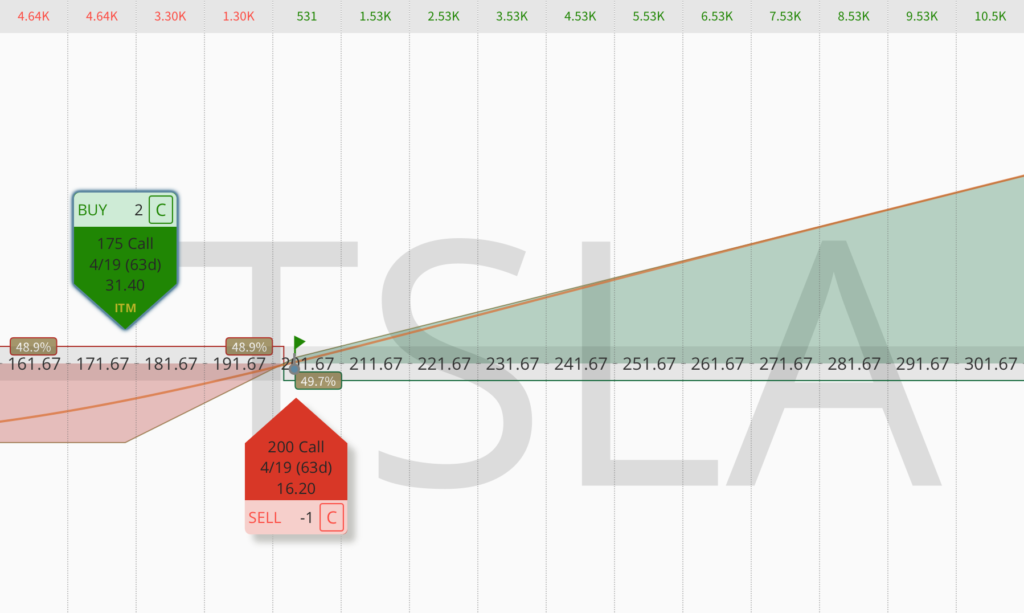The ZEBRA (zero extrinsic value back ratio spread) allows you to get close to the same directional exposure as owning 100 shares of stock, but with much less risk. It’s my favorite stock replacement strategy. In contrast to other stock replacement strategies such as synthetic long stock, risk reversal, or LEAPs, the ZEBRA provides substantial upside profit potential with reduced risk. What makes the ZEBRA particularly intriguing is its ability to address a prevalent challenge in options buying: decay. Decay signifies the gradual erosion of an option’s extrinsic value over time. By effectively eliminating this decay component, the ZEBRA strategy assists you in optimizing your performance.
Intrinsic and Extrinsic Value
Understanding intrinsic and extrinsic value is essential when dealing with options. Every option has two components: intrinsic value and extrinsic value. Intrinsic value is the real, tangible worth that you could immediately cash in if you executed the contract. For example, if you have a call option with a strike price of $30 on a stock currently trading at $45, the option already has $15 (*100) of actual value. You could exercise the contract, buy the shares at $30, and then sell them for $45.
On the other hand, extrinsic value represents the uncertain factors and future potential of the option. It takes into account variables like time remaining until expiration, volatility, and the chance of the option gaining intrinsic value. As the expiration date gets closer, the extrinsic value of an options contract starts to decrease, and this can be a major headache for options buyers. However, by combining long and short options, the ZEBRA strategy aims to manage the time decay differential between them.
Setting Up The Strategy
When setting up a bullish call ZEBRA trade, we buy two in-the-money call options below the current stock price (70 delta). To offset the extrinsic value associated with the long options, we simultaneously sell one at-the-money call option (50 delta). This trade configuration creates a near-100 delta bullish position, mimicking the exposure of owning 100 shares of long stock. The ZEBRA strategy incorporates an embedded stop-loss feature, similar to a married put strategy. The result is a similar setup to a married put, where you are protecting your risk on 100 shares of stock by purchasing an out-of-the-money protective put against the shares, but the huge benefit with the ZEBRA is that you’re not paying any extrinsic value to do so.
There is also the possibility of a bearish put ZEBRA trade, where we are buying two in-the-money puts (70 delta) and selling one at-the-money put (50 delta) to remove the extrinsic value and achieve near-100 negative deltas. This strategy acts like a married call, since the most you can lose is the debit paid, and you have 100 shares of short stock profit potential. The put ZEBRA is one of my favorite ways to short stocks, especially when I’m dealing with volatility ETNs. It’s a much safer option compared to traditional naked short stock positions, giving me protection from unlimited risk exposure.
The ZEBRA options position has a dynamic delta. As the underlying asset’s price fluctuates, the delta of the ZEBRA position changes due to the varying sensitivity of the long and short options to price movements. Keep in mind that the longer the DTE (days to expiration), the more expensive the ZEBRA position is. If the underlying stock pays a dividend, you will need to factor this into your profits. The ITM call options will be worth less on the ex-dividend date, as they will no longer have the right to receive the dividend.

Other Benefits of the ZEBRA
One of the significant challenges in options buying is the impact of time decay, also known as theta decay. The ZEBRA strategy effectively addresses this issue by eliminating the decay component associated with buying options. It improves the profitability of the overall position. The ZEBRA strategy has also another two main advantages:
- It minimizes your risk, especially tail risk. The most you can lose on a ZEBRA position is the net debit you paid for the strategy. In practice, the potential loss on a ZEBRA position can be less if managed early.
- It gives you significant upside profit potential. Unlike some stock replacement strategies that may limit potential gains, the ZEBRA offers substantial upside profit potential, and gets more and more stock-like as the price moves to the delta.
By selling short-term options against long-term options, the ZEBRA strategy provides the potential for generating income. This income can be used to offset costs or reinvest in other trading opportunities. I did weekly ZEBRAs and I sold premium against it. The extra short put or a short call against the ZEBRA helped reduce my cost basis.
Conclusion
The ZEBRA, or Zero Extrinsic Back Ratio, strategy offers an innovative approach to stock replacement. It allows you to replicate the same directional exposure as a stock position at a fraction of the capital. This is particularly advantageous for smaller accounts or traders seeking to optimize their capital allocation across different investments. From my personal experience and backtesting results, ZEBRA proved to be the most effective way to synthetically get long (or short).
The maximum loss in this strategy is the initial cost incurred for entering the trade. In contrast, owning 100 shares would necessitate significantly more capital, subjecting to larger potential losses. Managing the strategy early, usually around 21 days to expiration, can effectively reduct volatility in your profit or loss. Another way to enhance the probability of profit with the ZEBRA strategy is to leverage short-term options against your position. This means selling additional call (or put) options with a shorter expiration date and collecting more credit. With careful implementation and adherence to sound trading principles, the Zebra Options Trading Strategy can be a very useful tool in your options trading arsenal.
